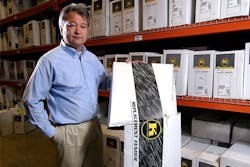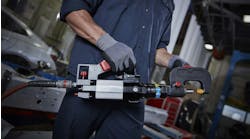Now vice president of sales and marketing for Keystone Automotive Industries, Inc., 48-year-old Chris Northup has spent his entire career in the automotive business. He started with Keystone in 1983, when the comp-any had about 200 employees, $12.5 million in sales and was just beginning to seriously branch out beyond bumpers to rust-replacement panels and hoods.
Keystone, which started in 1947 as a bumper re-chromer, now supports 26,000 collision repair customers and $700 million in sales with more than 4,000 employees. In October 2007, the company was acquired by LKQ Corporation, the country’s largest salvage yard owner, and while it’s not clear yet what changes the combined $1.5 billion, 260-location, 8,000-employee firm might bring to the $12 billion alternative replacement parts market, for Northup, the focus remains squarely on his body shop customers.
“Collision repairers are probably the last craftsmen that mainstream America approaches on a daily basis,” he says, describing the autobody market as pure Americana. “This is what this country was built on. It’s a hardworking, high work-ethic kind of business, with a very refreshing blue collar aspect to it.”
Three big-picture goals that Northup has learned matter the most to autobody professionals, meanwhile: “Meeting their service expectations, delivering the highest quality product possible and delivering a very competitive price—in that order.”
Despite occasional friction between shops and suppliers, then, Northup is proud to cheerlead for the way aftermarket parts can help body shop managers achieve those goals. “Whether you’re talking about recycled, remanufactured or new alternative parts, these parts offer a huge value for the collision repair customer,” he says. “It keeps more vehicles on the road and lowers the cost of repair, and that feeds right back to the American consumer. I end up feeling like I’m part of a really good story.”
He offers the following advice on how to get the best from your aftermarket parts distributor:
SEIZE THE COMMUNICATION PARADIGM
Put the burden of communication on your suppliers, Northup counsels. “It’s our responsibility to communicate with the customer to make sure everything is going alright,” he says. “We should make no assumptions about our customers. The best tool out there is good, solid conversation. It’s a lost art.” This business isn’t as highly technological as many, he points out—for the most part, ordering aftermarket parts still takes place over the phone. So this is still a relationship business, Northup notes, and in a relationship business, people need to talk.
EVALUATE YOUR SUPPLIER
Once you’re clear on the role of aftermarket parts at your shop—you’ve created a strategic place for them in your business model and overcome any philosophical hurdles related to non-OEM parts—evaluate your aftermarket supplier like you would any other, Northup advises. Does the supplier give you a level of service that’s compatible with your business needs in terms of cycle time and delivery hours? Does the supplier’s line of products meet your business needs, such as breadth of line and assortment of products for the mix of vehicles you tend to repair? If not, it might be time to search for a better one.
KNOW YOUR REP, KNOW YOUR SOURCE
There are, generally speaking, two kinds of aftermarket representatives, Northup notes—aftermarket suppliers who have spent their careers serving collision repairers and others who are general importers and aren’t necessarily all that knowledgeable about the current auto repair market.
The source of aftermarket products can make a difference, too, Northup says. Many companies make a point to source products from North America when they can, and when they work with overseas aftermarket parts manufacturers, they align with firms that have a good history and whose products meet the standards of a quality assurance program.
Determine what level of expertise you require from your supplier and what kind of standards you want in place for product sourcing, Northup says. Then ask your supplier about their experience and their sourcing policies. If you don’t get the answers you’re looking for, that might be another reason to shop for a new supplier.
WATCH FOR THE WEB
“We find that the best scenario for parts ordering is quickly becoming electronic,” Northup says. Right now, only 10 to 12 percent of aftermarket parts orders are placed online; the vast majority of orders still come through phone calls and faxes orders. Northup predicts, though, that within the next three years, Web-based ordering will be common, as will ordering parts exclusively by vehicle identification number (VIN). The shift to the Web and the use of VINs should improve the accuracy and speed of ordering aftermarket parts.
MORE ON COMMUNICATION
Until then, though, all those phone and fax orders mean lots of opportunities for mistakes. “When you place an order,” Northup advises, “give the year, make, model, specific trim information, like SE or LE—the more detail the better.” Too often, an order is called in as, “Send out a fender for a ’99 Accord, and get it here as quick as possible,” he notes.
Being specific about the timing also helps: If you ask for a part “right away,” Northup wonders, does that mean you need it shipped out today? First thing tomorrow? In the next couple of days? Giving an accurate time window can reduce both your wait time and the time the part spends sitting around the shop.
KNOW YOUR SUPPLIER’S RETURN RATE
Keystone, for example, reports a 19 percent return rate, and Northup compares that to dealerships’ rates—which average 13 percent—noting that dealerships handle parts for only one brand of vehicle, while aftermarket suppliers typically handle multiple brands. In Keystone’s case, 70 percent of the company’s returns are attributed to lost jobs.
“The estimate is in, parts are ordered, and later, the vehicle gets totaled or the customer decides not to do the repair,” Northup explains. Some parts are returned for application-related issues, Northup says. “For instance, a bumper for a Honda LX is required, but we delivered a DX bumper. That often goes back to mix-ups on the order.”
The dreaded non-fit return, meanwhile, accounts for less than 1.5 percent of the parts that are sent back. “Some 15 years ago, the non-fit was a bigger issue,” Northup says. “It has become less and less of an issue in today’s business environment. Even within the 1.5 percent of non-fits, some of those are highly subjective.”
“When you need to return a part, just notify your sales rep,” Northup adds, advising that most regular customers should see their sales rep a couple of times a week, if not every day—and that returns should be handled the same or next day. “There isn’t a lot of red tape,” Northup says of Keystone’s return policy. “We’ll come get the part and write you a credit, or bring you the part you want. That’s how I’ve done it since July 11, 1983.”
ASK FOR QUALITY
Always ask for the highest quality parts available. That might seem obvious, but Northup notes that many distributors offer varying levels of part quality. And while there might be room for that kind of range in the customer-pay market or among do-it-yourself enthusiasts, that shouldn’t be the case in the collision repair market, he says. Still, check it out. If, as the saying goes, a price sounds too good to be true, it probably is. “In my mind, you get what you pay for,” Northup says. “So you have to ask for highest quality product available.”
CUSTOMIZE YOUR ESTIMATING SYSTEM
“You’ve got to learn how to set up your own vendor selection profile when you’re using one of the electronic estimating systems that have parts sourcing features,” Northup explains. “There’s an opportunity to put multiple suppliers in your profile so you have more options when sourcing repair parts.” Taking the extra time and care to customize your software set-up will result in fewer assumptions and more accurate estimates.
DID WE MENTION COMMUNICATION?
All rules aside, success with aftermarket parts boils down to communication, Northup says. Talking with your customer, talking with the insurer, talking with your supplier—when you’re clear on your needs and the needs of the folks you’re working with, there’s less likelihood of error and a better environment for correcting mistakes when they happen. And that translates into more efficient repairs.
When your service expectations are known, Northup adds, the suppliers who want to stay in business—and who want to have your business—will do their best to meet those expectations. “There are a lot of suppliers who are new to the business, and they don’t yet understand the nuances that shops go through during a repair,” Northup says. “You have to get those things out on the table early on.”
Afterthoughts on Aftermarket Parts
Got an acute problem with your aftermarket supplier? OK, take a deep breath, remember that it probably isn’t personal—the incredibly fast recent growth of the aftermarket industry will inevitably create snafus here and there until the system catches up, and it seems to be steadily improving—but, above all, speak your mind, says Automotive Management Institute parts expert Tim Ronak.
“Aftermarket suppliers absolutely want to provide quality components and service, but, sometimes, it’s a little like a body shop detail department that all of a sudden gets 18 cars in at once, and it gets kind of difficult to get all of them clean fast enough,” Ronak says.
“So, unfortunately, for the system to improve, people need to complain when there’s a problem and consistently complain every time a problem happens if they can. In order for the system to improve, we also need to have an easy, simple, straightforward process to complain. Otherwise, how will manufacturers and suppliers get the feedback they need to improve?”
He stresses, however, that there’s a BIG difference between a legitimate, reasoned complaint and blowing your stack. One pushes change; the other alienates people and tends to delay it.
“The idea is to keep it constructive when you complain,” he adds, with empathy for how maddening a problem can be for shop owners who are already time- and money-stressed, themselves. “You need to be positive and constructive if we’re going to effectively push the aftermarket industry in terms of quality and performance.”
If you have to send a part back, for example, you should clearly document the reasons. Was there a problem with fit, and, if so, what was it exactly? Was the quality egregiously below what you were led to expect, and, if so, in what specific way? According to Ronak, “It’s not very constructive if you just send it back and say, ‘Sorry, not good enough.’”
He adds that in the wake of a mini-explosion of aftermarket parts in the U.S—recent figures show, for example, that they almost doubled as a percentage of parts dollars per appraisal over the last six years alone—manufacturers and suppliers are also highly motivated to work out the kinks on their end.
Ronak already sees seeds germinating for a better way of keeping track of CAPA certification updates, for example, and he envisions the Internet playing a key role in this and other aftermarket issues. Aftermarket parts that are certified but later decertified are a pet peeve for many shop owners, but existing industry Web sites might someday include a way for shop owners to routinely monitor certification updates, Ronak says. —Chuck Nowlen




